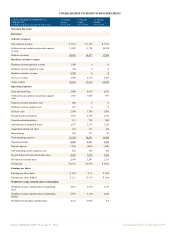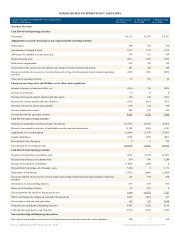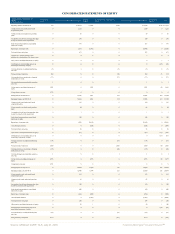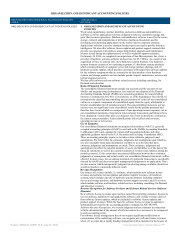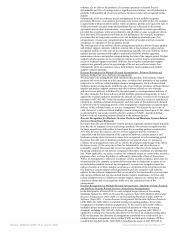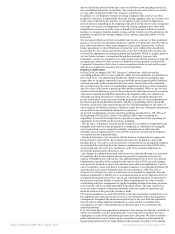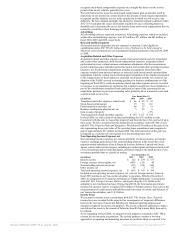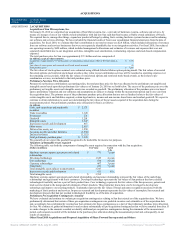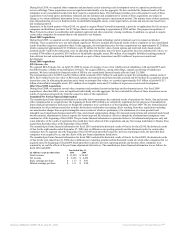Oracle 2009 Annual Report Download - page 187
Download and view the complete annual report
Please find page 187 of the 2009 Oracle annual report below. You can navigate through the pages in the report by either clicking on the pages listed below, or by using the keyword search tool below to find specific information within the annual report.
software; (2) we deliver the products; (3) customer payment is deemed fixed or
determinable and free of contingencies or significant uncertainties; and (4) collection is
probable. Substantially all of our new software license revenues are recognized in this
manner.
Substantially all of our software license arrangements do not include acceptance
provisions. However, if acceptance provisions exist as part of public policy, for example,
in agreements with government entities where acceptance periods are required by law, or
within previously executed terms and conditions that are referenced in the current
agreement and are short-term in nature, we generally recognize revenues upon delivery
provided the acceptance terms are perfunctory and all other revenue recognition criteria
have been met. If acceptance provisions are not perfunctory (for example, acceptance
provisions that are long-term in nature or are not included as standard terms of an
arrangement), revenues are recognized upon the earlier of receipt of written customer
acceptance or expiration of the acceptance period.
The vast majority of our software license arrangements include software license updates
and product support contracts, which are entered into at the customer's option and are
recognized ratably over the term of the arrangement, typically one year. Software license
updates provide customers with rights to unspecified software product upgrades,
maintenance releases and patches released during the term of the support period. Product
support includes internet access to technical content, as well as internet and telephone
access to technical support personnel. Software license updates and product support
contracts are generally priced as a percentage of the net new software license fees.
Substantially all of our customers renew their software license updates and product
support contracts annually.
Revenue Recognition for Multiple-Element Arrangements - Software Products and
Software Related Services (Software Arrangements)
We often enter into arrangements with customers that purchase both software related
products and services from us at the same time, or within close proximity of one another
(referred to as software related multiple-element arrangements). Such software related
multiple-element arrangements include the sale of our software products, software license
updates and product support contracts and other software related services whereby
software license delivery is followed by the subsequent or contemporaneous delivery of
the other elements. For those software related multiple-element arrangements, we have
applied the residual method to determine the amount of license revenues to be recognized
pursuant to ASC 985-605. Under the residual method, if fair value exists for undelivered
elements in a multiple-element arrangement, such fair value of the undelivered elements
is deferred with the remaining portion of the arrangement consideration recognized upon
delivery of the software license or services arrangement. We allocate the fair value of
each element of a software related multiple-element arrangement based upon its fair value
as determined by our vendor specific objective evidence (VSOE - described further
below), with any remaining amount allocated to the software license.
Revenue Recognition for Hardware Systems Products and Hardware Systems Related
Services (Nonsoftware Elements)
Revenues from the sale of hardware systems products represent amounts earned primarily
from the sale of computer servers and storage products. Our revenue recognition policy
for these nonsoftware deliverables is based upon the accounting guidance contained in
ASC 605, Revenue Recognition, and we exercise judgment and use estimates in
connection with the determination of the amount of hardware systems products and
hardware systems related services revenues to be recognized in each accounting period.
Revenues from the sales of hardware products are recognized when: (1) persuasive
evidence of an arrangement exists; (2) we deliver the products and passage of the title to
the buyer occurs; (3) the sale price is fixed or determinable; and (4) collection is
reasonably assured. Revenues that are not recognized at the time of sale because the
foregoing conditions are not met are recognized when those conditions are subsequently
met. When applicable, we reduce revenues for estimated returns or certain other incentive
programs where we have the ability to sufficiently estimate the effects of these items.
Where an arrangement is subject to acceptance criteria and the acceptance provisions are
not perfunctory (for example, acceptance provisions that are long-term in nature or are
not included as standard terms of an arrangement), revenues are recognized upon the
earlier of receipt of written customer acceptance or expiration of the acceptance period.
Our hardware systems support offerings generally provide customers with software
updates for the software components that are essential to the functionality of our systems
and storage products and can also include product repairs, maintenance services, and
technical support services. Hardware systems support contracts are entered into at the
customer's option and are recognized ratably over the contractual term of the
arrangements.
Revenue Recognition for Multiple-Element Arrangements - Hardware Systems Products
and Hardware Systems Related Services (Nonsoftware Arrangements)
In the third quarter of fiscal 2010, we early adopted the provisions of Accounting
Standards Update No. 2009-13, Revenue Recognition (Topic 605) Multiple-Deliverable
Revenue Arrangements (ASU 2009-13) and Accounting Standards Update 2009-14,
Software (Topic 985)—Certain Revenue Arrangements that Include Software Elements
(ASU 2009-14). ASU 2009-13 amended existing accounting guidance for revenue
recognition for multiple-element arrangements. To the extent a deliverable within a
multiple-element arrangement is not accounted for pursuant to other accounting
standards, including ASC 985-605, Software-Revenue Recognition, ASU 2009-13
establishes a selling price hierarchy that allows for the use of an estimated selling price
(ESP) to determine the allocation of arrangement consideration to a deliverable in a
multiple element arrangement where neither VSOE nor third-party evidence (TPE) is
available for that deliverable. ASU 2009-14 modifies the scope of ASC 985-605 to
Source: ORACLE CORP, 10-K, July 01, 2010 Powered by Morningstar® Document Research℠





